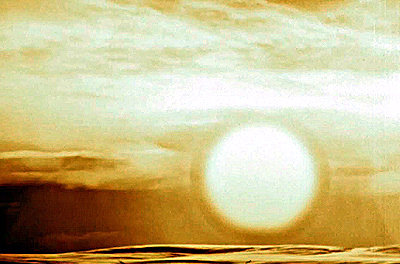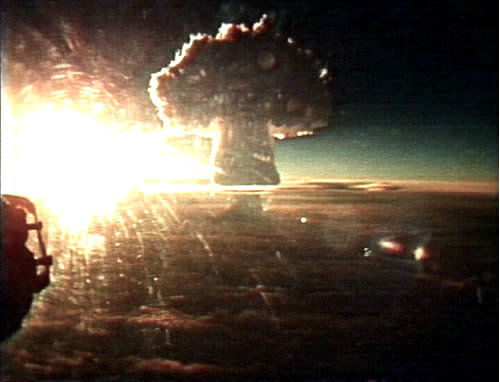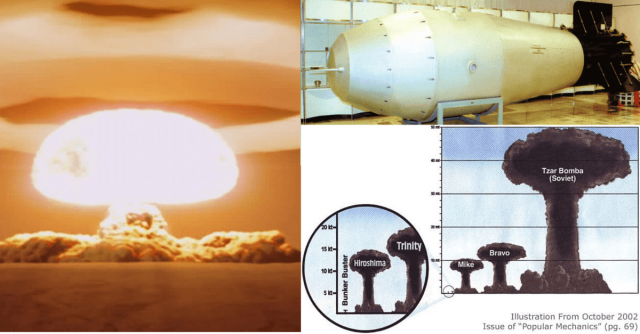Soviet-made Big Ivan or more commonly known as the Tsar Bomba holds the record for the world’s biggest bomb throughout history and here’s why.
Big Ivan showcased 57 megaton of USSR’s might. The Nagasaki and Hiroshima atomic bombings have to be multiplied 1,400 times to get in par with that. Furthermore, its power was all the fire power expended during the Second World War multiplied ten times.
So imagine all that destructive power in one bomb . . . in just one explosion.
But wait! These were only half of what it really was capable of.
Big Ivan: The Story
July 1961 — Nikita Khrushchev, the First Secretary of the Soviet Union’s Communist Party and the USSR leader in that time, decided that he was done with the unspoken nuclear testing freeze which his country as well as the US and the UK had been abiding to since 1958.
He wanted to show off USSR’s military might and the 22nd Congress of the Communist Party was the ideal venue to do just that. As it was convening October that same year and with all the world’s eyes focused on the nation, Khrushchev wanted to show the West who its boss was [Soviet Union, of course] and clinched that the best way to just do that was to set off the biggest man-made explosive of all time in a “spectacular test”.
But then, there was just one huge problem — the country did not possess a bomb big enough to suit the USSR leader’s tastes.
Until that point, the biggest hydrogen bomb the Soviet ever detonated was the inconsequential 3 MT RDS-37 which also was the first hydrogen bomb they built. However, Khrushchev wanted something bigger than that, something that would surpass and make the US’s 15 MT Castle Bravo test look weak. And, he wanted that kind of explosive ready by the time for the congress.
And since telling Khrushchev “no” just wouldn’t do, a four-man team was established for the project’s development comprised of Victor Adamskii, Yuri Babaev, Yuri Smirnov, and Yuri Trutnev. The fruit of their labors – which they had to simultaneously design and built in just a matter of 15 weeks – was the Big Ivan, the three-stage thermonuclear device that was 24 feet in length. It was officially designated as a AN602 hydrogen bomb.
Because of the time constraint, only such bomb was ever made and then, just barely.
Weighing 27 tons, the Big Ivan was as heavy as the Tu-95 that carried it. Additionally, it was so huge that the crew members had to cut the bomb-bay doors of the plane carrying it just to fit it in.
And on October 30, 1961 at exactly 11:32 AM, just as Khrushchev demanded, Big Ivan was dropped down from Andrei Durnovtsev’s plane at a height of 6.5 miles and steadily parachuted its way to the Mityushikha Bay test range in Novaya Zemlya. The world’s biggest bomb went “kaboom” at the height of 2.5 miles giving the plane merely 188 seconds to escape.
The Result

The fireball caused by the explosion of Big Ivan had a radius of nearly 10,000 vertical feet with its cloud mushroom reaching the height of 210,000 foot tall well into the stratosphere. The light coming from the reaction was seen from over one thousand kilometers while the force of the bomb’s explosion registered a 5.0 on the Richter scale. Furthermore, the resulting shock wave from the bomb’s explosion circled the earth thrice, generated air pressures that topped 300 PSI and even cracked windows in Finland and Norway, countries which were 900 kilometers away from the testing site.

Meanwhile, the empty buildings in the abandoned town of Severny which was fifty-five kilometers away from the site where Big Ivan was dropped off were totally leveled to the ground. later inspections revealed that ground zero had, reportedly, the texture of a skating rink.
As one eyewitness later recounted:
“The clouds beneath the aircraft and in the distance were lit up by the powerful flash. The sea of light spread under the hatch and even clouds began to glow and became transparent. At that moment, our aircraft emerged from between two cloud layers and down below in the gap a huge bright orange ball was emerging. The ball was powerful and arrogant like Jupiter. Slowly and silently it crept upwards…. Having broken through the thick layer of clouds it kept growing. It seemed to suck the whole earth into it. The spectacle was fantastic, unreal, supernatural.”
What’s more, all these were only half of what Big Ivan was really capable of doing.
For one, it possessed the design and was really built to deliver an astounding 100 megaton payload. Additionally, the Tsar Bomba was supposed to make use of fast-fissioning uranium tampers on its second and third stages. This would have caused a bigger reaction as well as a subsequent energy release. But then, USSR’s top brass ordered for the tampers to be swapped out and replaced with lead to prevent nuclear fallout from reaching and possibly affecting populated areas within USSR.
The lead tampers cut Big Ivan’s yield by half and also eliminated 97% of the resulting fallout. Because of this, Big Ivan may have been the biggest and most destructive man-made explosive device but it also holds one other distinction — being the “cleanest” among all other nuclear weapons being tested.
Fortunately, this record was only relevant for two years as after that time span, the Partial Test Ban Treaty – which put an end to above-ground nuclear weapons tests – was signed and implemented.
https://youtube.com/watch?v=aMYYEsKvHvk

